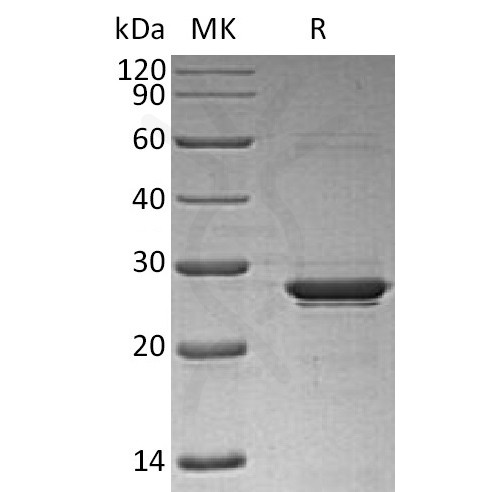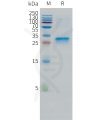| Target | |
|---|---|
| Synonyms | Oncostatin-M;OSM |
| Description | Recombinant Human Oncostatin M is produced by our E.coli expression system and the target gene encoding Ala26-Arg221 is expressed with a 6His tag at the N-terminus. |
| Delivery | In Stock |
| Uniprot ID | P13725 |
| Expression Host | E.coli |
| Tag | N-6×His Tag |
| Molecular Characterization | Not available |
| Molecular Weight | 24.44 KDa |
| Purity | Greater than 95% as determined by reducing SDS-PAGE. |
| Formulation & Reconstitution | Lyophilized from a 0.2 μm filtered solution of 20mMTris-HCl, 1mM EDTA, 200mM NaCl, pH 7.5. |
| Storage & Shipping | Store at -20°C to -80°C for 12 months in lyophilized form. After reconstitution, if not intended for use within a month, aliquot and store at -80°C (Avoid repeated freezing and thawing). Lyophilized proteins are shipped at ambient temperature. |
| Background | Oncostatin M (OSM) is a glycoprotein belonging to the interleukin-6 family of cytokines that includes leukemia-inhibitory factor, granulocyte colony-stimulating factor, and interleukin 6. OSM encodes a growth regulator, which Inhibits the proliferation of a number of tumor cell lines. It stimulates proliferation of AIDS-KS cells. OSM regulates cytokine production, including IL-6, G-CSF and GM-CSF from endothelial cells. OSM is considered as a pleiotropic cytokine that initiates its biological activities through specific cell surface receptors. The low affinity LIF receptor that shares the similarity of containing protein gp130 has now been identified to be a component of a high- affinity OSM receptor that will transduce OSM signals. OSM has also been shown to play a role in both pro and anti-inflammatory actions. OSM may also be involved in many biometabolism processes including liver development, haematopoeisis, inflammation, bone formation and destruction and possibly CNS development. |
| Usage | Research use only |
| Conjugate | Unconjugated |
Human OSM (N-6His) Protein
Price: 50 μg $503.00
Product Data Dima FAQ
Images Dima FAQ

Figure 1. Greater than 95% as determined by reducing SDS-PAGE.
Related Products
ECD Proteins
SKU: PME101508 Target: OSM Tag: C-10×His tag
Price:10μg $95.00 ; 50μg $330.00 ; 100μg $500.00

